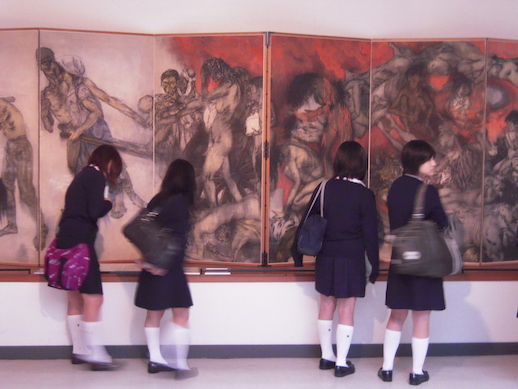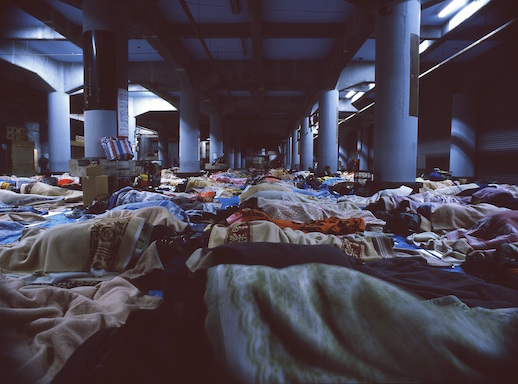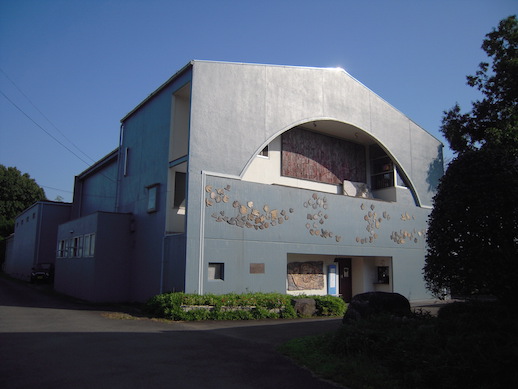Maruki Gallery for the Hiroshima Panels Looks Ahead

Maruki Gallery for The Hiroshima Panels in Higashi-Matsuyama, Saitama is at a crossroads. The museum is home to “The Hiroshima Panels,” a set of paintings by the Nobel Prize-nominated artists Iri and Toshi Maruki that depict the horrors and human impact of the atomic bombings. Hit hard by the COVID-19 crisis, which dented the visitor numbers it depends on for survival, the 53-year-old facility has put out a call for financial donations to keep its doors open and fund preservation work for the panels. The gallery also has new projects on the horizon. Tokyo Art Beat contacted curator Yukinori Okamura for an update on the fundraising progress and the museum’s goals.
What keeps “The Hiroshima Panels” relevant? Why are they important in this present moment? What other kinds of artwork does the gallery exhibit?
As artworks that depict the horrors of the August 1945 atomic bombings, the panels convey the pain of destruction that humans had never before experienced. Of course this is a pain that cannot be fully imagined by those who have not experienced it, but with self-centered and nationalistic thinking on the rise in today’s world, it is more important than ever to attempt to share the pain of others through creative expression.
In addition to “The Hiroshima Panels,” Iri and Toshi Maruki also created the paintings “The Rape of Nanking,” “Minamata,” and “Auschwitz,” as well as other works depicting human tragedies of the 20th century. The gallery also displays works by Suma Maruki, Iri’s mother, who began painting after the age of 70. Her works exude the joy of living freely.
The gallery put out a call for donations earlier this year, citing a need for funds for its survival. How successful has the fundraising been? What will these funds go towards?
We haven’t yet confirmed the final donation amount, but at this point we estimate we’ve raised more than 50 million yen from over 5,000 people. This is the first time we’ve tried online donations, and we’ve seen a big result with people of various ages from across Japan and around the world donating. The donations will go towards running the museum and preserving and repairing the “The Hiroshima Panels,” among other projects.
I understand you’re working on creating virtual tours for the panels. Can you tell me about this project?
We registered with the U.S. donation site Global Giving and are asking for donations to make videos. We’ve received more than $6,000 from about 60 donors and aim to make the virtual tour videos within the year. We’ve asked Takashi Arai, an internationally acclaimed daguerreotype photographer who has also been working in film in recent years, to produce the videos. We would like for the “The Hiroshima Panels” to be widely known internationally. We hope to lay a foundation for supporting the museum on an international scale as an asset shared by humanity.

How have operations been since the museum reopened? Can you tell me about the current exhibition of photography by Katsumi Sunamori? How does his work fit with the gallery’s mission?
Thanks to newspaper, TV, and other reports, plus social media, we’re seeing more visitors to the museum than in typical years. However, the pandemic has caused school group visitations to be cancelled, so the outlook is certainly not rosy.
The Katsumi Sunamori exhibition is a limited-time show curated by the photography critic Noi Sawaragi. Sunamori passed away 11 years ago, but his work involved walking the streets and photographing Kamagasaki and the skid rows of Osaka, the slums of Hiroshima where atomic bomb survivors lived, the town of Unzen, which was devastated by volcanic eruption, the U.S. military bases of Okinawa, and other places where people live with painful memories. I believe his perspective is prescient in these times of ongoing disaster and that it has the power to connect the pain depicted in the Maruki’s works with the present day.
What kinds of exhibitions and events does the museum have planned for the future? What kind of future do you envision for “The Hiroshima Panels?”
As the situation with the corona virus is still uncertain, it is difficult to make concrete plans for too far in advance, but we will continue holding exhibitions by contemporary artists who portray social issues and the value of life.
By displaying works by contemporary artists along with “The Hiroshima Panels,” we hope to bring out connections between their different eras and expressions. This puts a contemporary perspective on history. I think it is also a meaningful experience for artists and a stimulating and fresh experience for visitors. Through these opportunities, the spirit of the Marukis can reach more people. If we can gradually change how society is viewed, I believe it opens up new possibilities for “The Hiroshima Panels” and the Maruki Gallery in the present era.




